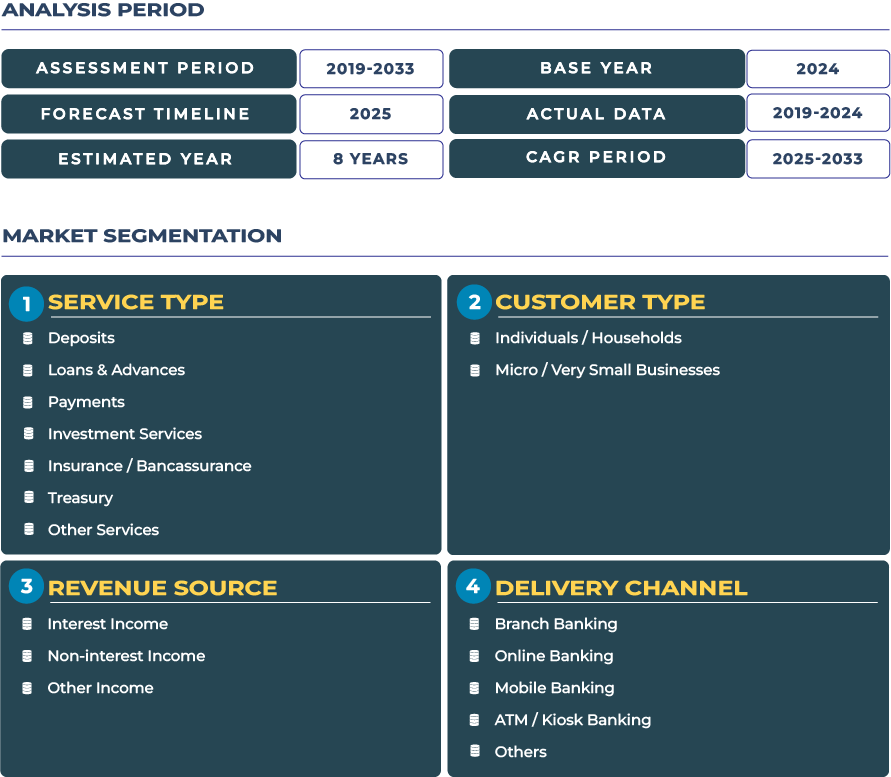SME-Centric Digital Banking Expansion: Italy Retail Banking Market in Focus
Italy is positioning itself as a testing ground for retail banking models focused on digitally enabling small and medium enterprises (SMEs) and underserved regions. With a historically fragmented banking network and regional disparities, Italian banks are increasingly investing in digital lending platforms, mobile wallets, and fintech partnerships to draw in SMEs previously underserved by conventional credit models.
Note:* The market size refers to the total revenue generated by banks through interest income, non-interest income, and other ancillary sources.
Market Outlook: Mapping Italy Retail Banking Trajectory into the Next Decade
Over the 2025–2033 horizon, the Italian retail banking sector is expected to expand from USD 63.8 billion to USD 74.9 billion, corresponding to a CAGR of 2.0%. Core banking services-savings, mortgages, consumer credit-will remain foundational. Yet, the primary growth engine will shift toward digital-first products: instant payments, SME digital credit, merchant services, and insurance cross-sell embedded into transactions. The unique challenge for Italy is that many regions remain underbanked or underserved, and consumer trust, regulatory complexity, and legacy system inertia still present headwinds. Macroeconomic pressures-such as inflation, public debt constraints, energy prices, and external shocks-will further test margins and credit demand. Italian banks that can scale digital infrastructure, carve out SME segments, and orchestrate cross-product journeys will differentiate in the evolving retail banking ecosystem.
Drivers & Restraints: Underlying Forces Shaping Italy Retail Banking Evolution
Driving Forces: State Support, Digital Uptake & Fintech Momentum
One driver is government and regulatory support for digital banking transformation, especially in underserved regions. Italy has emphasized digitalisation in its national strategies, and European funds are allocated to bolster connectivity and digital inclusion. The European Investment Bank’s summary report on SME digitalisation underscores the need for more financing for digital projects and increased SME capacity to adopt these technologies. Additionally, smartphone penetration and consumer adoption of online financial services continue to rise, providing a foundation of digital readiness. On the fintech front, startups are accelerating to address niches. For example, Tot, an Italian fintech, raised €7 million in a recent funding round to back SME digital growth. These dynamics create opportunities for banks to partner, acquire, or embed fintech modules to scale offerings rapidly.
Restraining Currents: Bureaucracy, Rural Penetration Gaps & Compliance Burden
However, structural and institutional challenges hamper speed. Bureaucratic inertia, regulatory fragmentation, and slow adoption in rural or less affluent regions slow digital banking diffusion. Many potential customers lack banking documentation or digital literacy, which raises onboarding friction. Operational compliance costs-covering anti-money-laundering (AML), Know Your Customer (KYC), data protection, and risk oversight-are high, especially for digital models scaling into smaller accounts. Additionally, fraud risk is rising: evidence shows criminals are using AI and synthetic identity techniques to open accounts and wallets remotely in Italy, presenting challenges for remote onboarding and identity verification. Thus, banks must balance innovation with rigorous risk and control frameworks.
Trends & Opportunities: What’s Defining Italy Retail Banking Horizon
Trend: Surge in Peer-to-Peer Lending, Neobank Penetration & Digital Wallet Growth
A strong trend is the proliferation of peer-to-peer (P2P) lending platforms and neobank expansion across Italian cities, especially among younger and underserved borrowers. These platforms reduce intermediation friction and improve credit access in thin segments. Meanwhile, digital wallets and instant payments through networks like Bancomat and PagoBancomat are evolving. Notably, Bancomat’s cross-border instant payment alliance with Spanish Bizum and Portuguese SIBS (EuroPA) began enabling mobile payments across Italy, Spain, and Portugal. The rise in digital wallet usage opens pathways to embed banking services-loans, insurance, loyalty-into day-to-day spending flows. As consumers and small businesses adopt digital payments, banks can monetize transaction flows, data, and cross-sell opportunities.
Opportunity: SME-Focused Digital Lending & Embedded Finance Solutions
The biggest opportunity is in scaling SME-centric digital lending and embedded finance models. Many Italian SMEs historically rely on informal credit or family financing; offering streamlined app-based credit, dynamic risk scoring, and real-time cash flow lending can shift behavior. Banks can embed lending and payment modules into merchant point-of-sale systems or e-commerce platforms. Partnerships or acquisitions of fintechs specialized in SME credit analytics can accelerate capability. Another opportunity is embedding insurance, loyalty, and subscription financing into everyday transactions-turning banks into platforms of value rather than siloed product providers. Finally, hybrid advisory (digital plus human touch) could nurture wealth and advisory services into emerging segments, especially given that financial literacy and confidence strongly influence adoption of robo-advisory solutions in Italy.
Competitive Landscape: Strategic Moves Among Italian Retail Banking Players
Key players include UniCredit, Intesa Sanpaolo, Banco BPM, Monte dei Paschi di Siena (MPS), BPER Banca, and others. UniCredit is actively deploying AI tools: it uses an internal platform (DealSync) to surface M&A targets by analyzing 2,000+ leads, which shows its ambition to transcend traditional banking via analytics. (News) MPS launched a takeover bid for Mediobanca, aiming to combine retail banking with wealth management capabilities. (News) In terms of digital channels, Webank (now part of BPM) remains a reference point in online banking, specializing in digital deposits, credit, and securities. Many incumbents are partnering with fintechs or developing internal labs to focus on SME lending, digital payments, and embedded solutions. Moreover, regulatory pressures and EU-level scrutiny on Italy use of “golden power” to limit foreign bank deals may affect consolidation trajectories in the sector. The competitive battleground is no longer just branch networks but data velocity, modular architecture, risk controls, and platform monetization.







